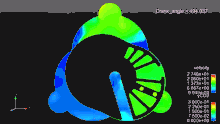LiquidPiston is the developer and manufacturer of a pistonless rotary engine called the X-engine, located in Bloomfield, Connecticut.


X-engine
X engine is a hybrid cycle rotary engine.
Mechanical design
This is essentially an inverted Wankel engine that operates on the high-efficiency hybrid cycle.[1][2] In the Wankel, the only successful pistonless rotary engine to date, an oval-like epitrochoid housing surrounds a curved sided triangular rotor. The rotor revolves around the central output shaft in a wobbling hula-hoop motion. The rotor pushes the output shaft via toothed gears. One power pulse is delivered in one revolution of the output shaft. The output shaft revolves at three times the speed of the rotor. For comparison a four-stroke piston engine delivers one power pulse for two rotations of the output shaft. The three operating chambers of the Wankel formed by the triangular rotor are separated by seals installed on the three apexes of the rotor. These seals move in and out during each hula-hoop rotation of the rotor, being subjected to high stresses and wear. As a result, they have been a limiting factor in durability of such engines. The LiquidPiston design reverses the shapes: an oval rotor moves within a triangular housing. The required seals (both face and apex) are mounted on the stationary housing, and are lubricated directly. The rotor has ports to supply air and remove exhaust gas, thereby eliminating the need for valves.
Operating principle
This cycle consists of compressing air (with no fuel) to a very high ratio, as is typical in the Diesel cycle. The air is then isolated in a constant volume chamber. Fuel is directly injected being allowed to combust fully under constant volume conditions, which is how Otto cycle combustion is modelled. Finally, the combustion products are expanded to atmospheric pressure, utilizing the Atkinson cycle.
Feasibility
In order to use the Diesel cycle efficiently, high compression ratios are required. Typical piston diesel engines use between 15:1 and 24:1. The LiquidPiston engine was demonstrated on the Diesel cycle with a compression ratio as high as 26:1.[3] This would generally rule out the use of low octane fuels like gasoline, so there is also a lower compression spark ignited version called the X-Mini. The X-Mini is a 70 cc air-cooled naturally aspirated four-stroke X-Engine variant, that has been operated on a variety of fuels using spark ignition including gasoline, kerosene, jet fuels including Jet A, as well as propane and hydrogen.[4]
References
- ↑ Shkolnik, Nikolay; Shkolnik, Alexander (2006). High Efficiency Hybrid Cycle Engine. ASME Internal Combustion Engine Division 2006 Spring Technical Conference.
- ↑ Nabours, Stephen; Shkolnik, Alexander; Shkolnik, Nikolay; Nelms, Ryan; Gnanam, Gnanaprakash (April 2010). 2010 SAE World Congress: High Efficiency Hybrid Cycle Engine. Society of Automotive Engineers, World Congress. Detroit, MI, US. Paper 2010-01-1110. Archived from the original on February 29, 2012.
- ↑ Warwick, Graham (June 20, 2018). "Liquid Piston's Rotary Engine Could Boost UAS, Accelerate eVTOLs". Aviation Week Network. Retrieved December 19, 2020.
- ↑ Nichols, Greg (June 25, 2021). "LiquidPiston engine now runs on hydrogen". ZDNet. Retrieved January 4, 2023.
External links